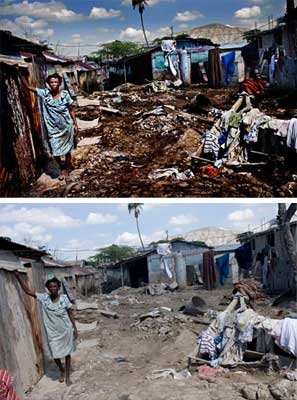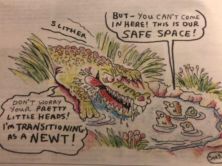
The image on the bottom was the original file before Photoshop was employed. The difference between the two images is astonishing.
A recent decision by a panel of judges to disqualify a Danish photojournalist from a photography contest due to excessive use of Photoshop raises questions about the ethical application of new technologies.
Klavs Bo Christensen’s pictures were removed from the Danish Union of Press Photographer’s “Picture of the Year” contest when judges compared his images to his RAW files and noticed he used exaggerated coloration in his submissions.
According to the rules published by the organization: “Photos submitted to Picture of the Year must be a truthful representation of whatever happened in front of the camera during exposure. You may post-process the images electronically in accordance with good practice. That is cropping, burning, dodging, converting to black and white as well as normal exposure and color correction which preserves the image’s original expression.”
The judges called Christensen’s color-saturated work “unacceptable.” (From imediaethics’s perspective that is an understatement. The departures from the original photos are stunning. See For yourself).
‘”It should not mean that we do not accept or recognize editing in Photoshop, but this example is really extreme,” said judge Miriam Dalsgaard.
Christensen disagreed: “In my opinion, a RAW file … has nothing to do with reality and I do not think you can judge the finished images and the use of Photoshop by looking at the RAW file,” he told Jens Tønnesen, Web master for the Union of Press Photographers.
According to Editor-in-Chief David Schlesinger, Reuters’ strict guidelines for using Photoshop echo those of the contest as well as of most journalistic entities. They state that while basic color correction is OK, dramatic color changes “mislead the viewer” and are not allowed.
Astrophotographer and author Jerry Lodriguss , who admits he has been criticized for using excessive digital imaging in his work, feels that the intent factors in on whether it is ethically acceptable to alter a photograph. Was the person intending to deceive? Ladriguss also believes photographers tread a fine line between ethics and aesthetics when digitally manipulating photos:
“If you add something that wasn’t there in the original scene, you’ve crossed the line from a documentary art form into a fictional one. This may or may not be OK, depending on what your purpose is. If your purpose is to portray a scene as truthful, then it’s not OK. If your purpose was to create fiction, or ‘art ‘, then it is OK. You just have to be up front and tell the viewer what you are doing in either case.”






The original RAW image and the final may look very different but that doesn’t necessarily mean the final is further from what the *eye* originally saw. Cameras in bright sunlight often flatten images – all amateur photographers experience this when their sunsets come out disappointing flat. A photo is by definition not an exact copy of nature.
You say the departure from the original is ‘stunning’. But you don’t know how far the departure from the original is because you weren’t there. The original no longer exists. If the eye perceived squalor and this photo reflects that perhaps the photo is more true than the original flat RAW.
It seems clear to me that the saturation is overly done here but the issue is not as clear as it seems.
“Cameras in bright sunlight often flatten images – all amateur photographers experience this when their sunsets come out disappointing flat. A photo is by definition not an exact copy of nature. ” by Gazzer
——————————-
As an amateur photographer, I agree that it is challenging to get the camera to capture what is really being seen. However with a digital camera, you can take easily take several shots, bracketing them with different exposure levels, or simply preview them on the camera. I agree with the disqualification. Christensen went to far with Photoshop.
My feelings on this are mixed. The photo feature in this article was probably the most extreme example, but I can’t call these massive alterations. The reason? Film.
Back before digital cameras, photogs would pick their film based off of how they liked its properties. For example, Kodachrome was well known for showing strong oranges and reds when used. Or when using Fuji Velvia 50, because it has very rich blues and greens.
A large portion of "Consumer" grade films are very heavily saturated compared to certain professional films.
A faster film will (typically) have higher contrast and may look "grittier"
So, if we can pick film and how we process it in order to get the contrast or color that we want, is it more honest? Is it because we have to work harder and there’s nothing to compare it to that it isn’t factual?
By the logic presented here we should condemn Vietnam war photographers for taking photos with grainy high-speed black and white films, saying that they chose that gritty looking film to "punch up" their images.
I’m all for keeping journalistic works from cloning or adding items to a photo, but if we’re going to argue over contrast and saturation, we’ve already lost the choice as to how to present our perspective as a photographer.
Any photographer who works from RAW files knows that post-processing determines the characteristics of the picture. The RAW image itself cannot be interpreted without post-processing. Someone made decisions about exposure, contrast, etc, when printing the "true" RAW image used for comparison to the "altered" image. In any case, as another poster noted, the difference is similar to the effects of choosing adiffernet film like Velvia in the old days of film. It is not essentially different from Ansel Adams working to extract his vision from a B&W negative by increasing contrast in some of his prints. The judges’ decision in this case is unjustified and poorly-reasoned.
This is absolutely ridiculous! Everyone knows Raw flies require lots of posprodcution precisley because it delivers such a grey image! It’s grey so the photographer takes out all the detail and tunes it to what he/she saw. Otherwise we would be using jpg’s in the full blast saturation/contrast/sharpness and loose a lot of information. Would this mean Salgado is the highest cheater because he uses fine b&w printing? Looking at his recent digital work one would guess that there is a lot of fine printing on it, would his amazing work be lost to photojournalism just because his printer knows how to print?
Really, art photography has already assumed this, why can’t the photojournalism world just get on with it? Of course adding and cloning is out of the question, but saturation and contrast?